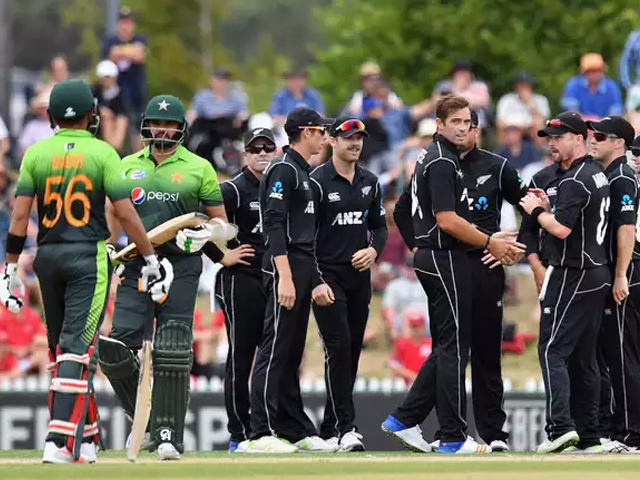
Tim Southee of New Zealand (C) is congratulated by team mates after dismissing Azhar Ali of Pakistan during the second match in the One Day International series between New Zealand and Pakistan at Saxton Field on January 9, 2018 in Nelson, New Zealand. PHOTO: GETTY
#PAKvsNZ: 3 reasons why the Kiwis whitewashed the Men in Green with ease
Top & middle order batsmen were guilty of not moving their feet, but Amir & Hasan gave the most disappointing bowling.
When Pakistan first stepped onto Kiwi shores, the probability of a fairly close contest was higher than Pakistan’s previous tours, but as things panned out, that was not the case. While the series defeat was not necessarily a bolt out of the blue, the more startling aspect was the enormous regression of the state of our team.
By the time Pakistan looked towards getting a win in the series – they came close in the last two ODIs – it was too late as New Zealand already had an unassailable lead in the series.
 New Zealand pose with the series trophy, 5th ODI, Wellington, January 19, 2018. Photo: Getty
New Zealand pose with the series trophy, 5th ODI, Wellington, January 19, 2018. Photo: GettyBatsmen falter
Facing up to the New Zealand bowlers in home conditions was always going to be a daunting task, but the lack of application and unwillingness to drop anchor meant that the visiting batsmen were dismissed rather easily and comically at times.
Most of Pakistan’s top and middle order batsmen were guilty of not moving their feet, which is crucial while tackling the swinging ball, and some atrocious shot selection consequently meant that they were just lambs to slaughter more often than not.
Babar Azam’s batting has been like music to the ears as he has been Pakistan’s most successful batsman over the past 12 months, however, this ODI series proved to be a tough one for the youngster. He averaged a shade over six runs per innings, indicative of a series he would quickly want to forget about. He is a talented batsman and if he is willing to improve, this series must have been a good learning curve for him.
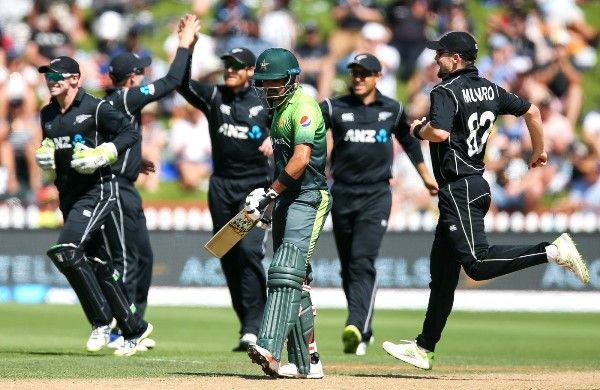 Babar Azam's horror run continued in the final ODI, New Zealand v Pakistan, 5th ODI, Wellington, January 19, 2018. Photo: Getty
Babar Azam's horror run continued in the final ODI, New Zealand v Pakistan, 5th ODI, Wellington, January 19, 2018. Photo: GettyShadab Khan was the third highest run scorer for Pakistan in the series, behind Mohammad Hafeez and Fakhar Zaman, which must be embarrassing for some of the proper batsmen in this side.
Having said that, one of the bright spot amidst the gloom was the batting of Haris Sohail in the middle order who grabbed the opportunity with both hands in the final two ODIs and notched up back to back half centuries. He could become a valuable addition to Pakistan’s middle order if he remains consistent and avoids injury concerns, which have haunted him throughout his short career.
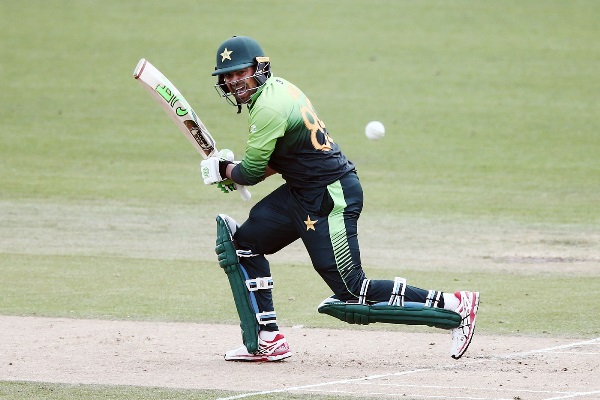 Haris Sohail was good both sides of the wicket, New Zealand v Pakistan, 4th ODI, Hamilton, January 16, 2018. Photo: Getty
Haris Sohail was good both sides of the wicket, New Zealand v Pakistan, 4th ODI, Hamilton, January 16, 2018. Photo: GettyThe opening conundrum and should Sarfraz Ahmed bat up the order?
The inability of Pakistan’s middle order to keep the scoreboard ticking by playing risk-free cricket especially during the middle stage of the innings is a constant worry. Batsmen often lose their wickets trying to get rid of the shackles and try for boundaries, hence in this stage, there is a need for a batsman who is accustomed to milking the bowlers for singles and doubles regularly. This makes a strong case for Sarfraz to bat higher up the order because of his good track record in this particular position.
The numbers also back Sarfraz in this regard. Both his average and strike rate is significantly higher whenever he has batted in positions four and five as compared to his usual number six spot.
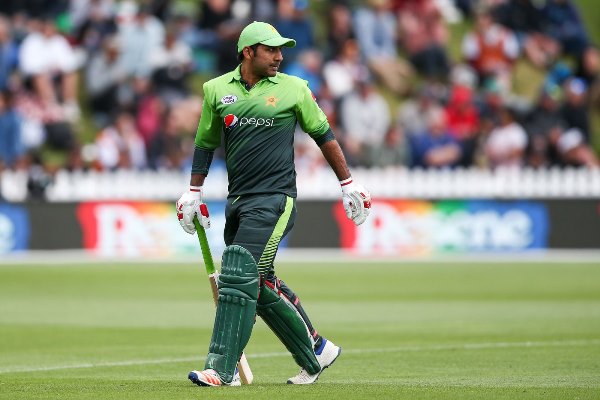 Sarfraz Ahmed walks back after being dismissed, New Zealand v Pakistan, 1st ODI, Wellington, January 6, 2018. Photo: Getty
Sarfraz Ahmed walks back after being dismissed, New Zealand v Pakistan, 1st ODI, Wellington, January 6, 2018. Photo: GettyThe last thing you want to do with an already fragile batting is fix square pegs into round holes. Whether it was Faheem Ashraf’s promotion to the top of the order or using a different opening pair in almost every match; the team management must avoid such antics in the future.
It was bizarre to see Pakistan use their only proper finisher, Faheem, for the opening slot; I wonder what kind of thinking was behind that. How do you expect a player from the lower order to counter the bowlers when your premier batsmen were toothless against them?
With one eye on the 2019 World Cup in England, Pakistan need to realise that opting for make-shift openers is not the correct ploy. They need to plan accordingly for the future and stick with either Fakhar/Azhar Ali or Fakhar/Imamul Haq and persist with them rather than chopping and changing at the first available opportunity.
Pakistani bowlers came off second best
The Kiwi pacers consistently were much more consistent as compared to their counterparts. They stuck to a short of good length or good length with accurate line on and around off stump, to constantly trouble the visitors. Pakistani bowlers could not replicate enough of the similar line and length and hence struggled.
With Trent Boult and Tim Southee at their regal best, supplemented by the raw pace of Lockie Ferguson, Pakistani batsmen looked like ill-prepared soldiers on a war front. The trio took full advantage of the conditions on offer and were as good as Rafael Nadal on clay courts.
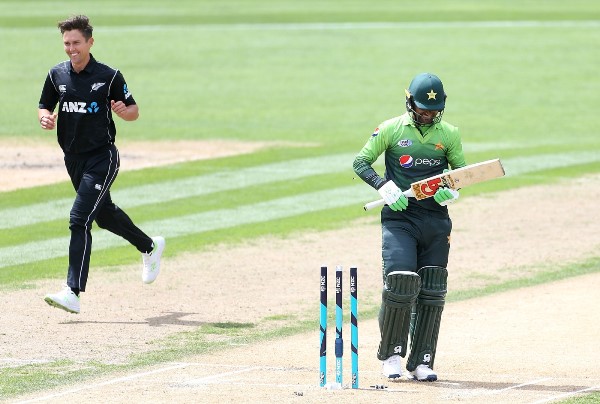 Fakhar Zaman was bowled by Trent Boult in the fourth over, New Zealand v Pakistan, 3rd ODI, Dunedin, January 13, 2018. Photo: Getty
Fakhar Zaman was bowled by Trent Boult in the fourth over, New Zealand v Pakistan, 3rd ODI, Dunedin, January 13, 2018. Photo: Getty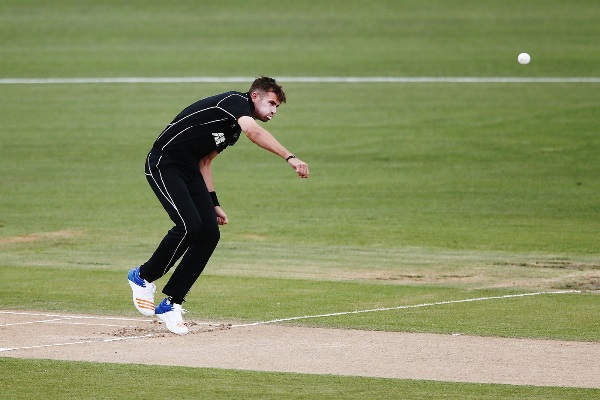 Tim Southee pushed Pakistan back with early strikes, New Zealand v Pakistan, 4th ODI, Hamilton, January 16, 2018. Photo: Getty
Tim Southee pushed Pakistan back with early strikes, New Zealand v Pakistan, 4th ODI, Hamilton, January 16, 2018. Photo: GettyNew Zealand bowlers were far more efficient with the new ball and made it count by picking up wickets right from the outset, which is evident from the major disparity in average first power play scores of both sides. The home side averaged 54/1 during the first 10 overs while the men in green could only score 33 runs for the loss of three wickets on average during their five outings with the bat.
Unlike the New Zealand bowling attack, Pakistan’s bowlers did not bowl as a cohesive bowling unit and performed well only in patches, with absence of pressure at both ends on most occasions during the matches.
Perhaps the most disappointing aspect of Pakistan’s bowling was Mohammad Amir. In suitable bowling conditions, his performance was particularly mediocre. He failed to get wickets with the new ball and was indifferent at the back end of the innings as well. The left-arm pacer picked up just a couple of wickets at an average of 72.5, which did not help the team’s cause as he was the most experienced bowler on the side.
Despite being the number one ODI bowler in the world, Hasan Ali was not at his usual best during the series, which also had a negative impact on the potency of Pakistan’s bowling attack.
Shadab, on the other hand, had decent outings with the ball despite the conditions that were not very helpful to facilitate his leg spin-bowling. Rumman Raees and Faheem had their moments at certain stages during the series but at no point could they come up with a match-winning spell.
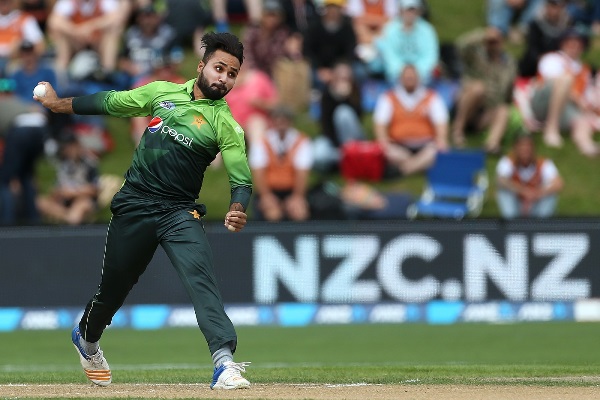 Faheem Ashraf nipped out Colin Munro early, New Zealand v Pakistan, 3rd ODI, Dunedin, January 13, 2018. Photo: Getty
Faheem Ashraf nipped out Colin Munro early, New Zealand v Pakistan, 3rd ODI, Dunedin, January 13, 2018. Photo: GettyPakistan’s miserable time during the ODIs on tour may have ended but they will have to quickly recover from this humiliating defeat because the T20 series is not too far away and the Kiwi side is surely going to come hard at them once again.




COMMENTS (6)
Comments are moderated and generally will be posted if they are on-topic and not abusive.
For more information, please see our Comments FAQ